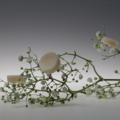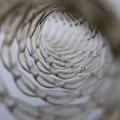Nature-inspired hierarchical material design: exploring micro- and nanoscale pores for enhanced functionality

∼
Hierarchical materials are of particular interest because they enable the material to have a wider range of functionalities. As an illustration, the human bone, which is made up of both inorganic and organic phases together, has exceptional strength and toughness. In this research project, inspired by nature, researchers from the Multifunctional Materials Design research group attempted to create a hierarchical structure made up of micro- and nanoscale pores. This could be accomplished by combining the self-assembly of block copolymer (nanostructures) and water droplets (microstructure). Python was used as an image processing tool to quantitatively characterize the dimension of the hierarchical structure. Furthermore, the dip-coating technique used for film deposition is a facile technique that can be scaled up to industrial levels. To the best of our knowledge, this work is the first one to report the combination of water droplet, block copolymer, and silica nanoparticles self-assembly in one thin film material. This unique network can serve as a fascinating platform for catalytic applications.
Understanding and connecting the various experimental parameters that lead to the construction of the structure is the most difficult aspect of the investigation. "The self-assembly of water droplet, block copolymer or silica nanoparticles alone is already difficult to predict, not to mention when they are combined in the same process. Nevertheless, we have successfully proposed a universal mechanism that explains and links the various forces involved", says doctoral candidate Hoang M. Nguyen.

In this work, the researchers employed the emulsion breath figure technique to create a porous template using silicon dioxide nanoparticles and block copolymers as water droplet stabilizers. They examined the influence of dip-coating speeds, surface wetting characteristics, and nanoparticle size on the morphologies of the pores. The assisting author, Dr. Swarnalok De, contributed to the project by collecting SEM data and writing and editing the content. "It was indeed a fascinating endeavor when we eventually obtained the “beautiful” porous structures having three different self-assembly processes in one material. We anticipate that the fabrication route described in this work will be of particular interest to scientists in the field of catalysis", says Dr. De.
According to Hoang M. Nguyen, since he knew little about Python in general, this project taught him a lot, particularly about Python coding. "Python is a far more accurate and flexible image processing tool than ImageJ, which is typically utilized in the community of physical sciences. Additionally, a collaboration "dare" seminar in our lab served as the catalyst for teamwork in this project. The seminar aims to promote collaboration between team members by educating researchers on how to overcome hesitation and to better approach other researchers”, adds Nguyen.
The research was published in ChemistrySelect, Volume 8, Issue 13 (Hoang M. Nguyen, Ariane V. Mader, Dr. Swarnalok De, Dr. Fevzihan Basarir, Prof. Jaana Vapaavuori).
§§ About the author: Hoang M. Nguyen is in the final year of his PhD and is in the process of completing his thesis. The thesis delves into the investigation of the self-assembly of various types of thin film materials, encompassing a range from nano to microscale. Simultaneously, Hoang holds the position of a Process Engineer at ASM, a company specializing in atomic layer deposition for thin films used in the semiconductor industry. When it comes to his areas of particular interest, Hoang exhibits unwavering enthusiasm and an ability to engage in everlasting discussions, primarily centered around topics such as atomic layer deposition, thin film characterization techniques like X-ray reflectivity (XRR), X-ray photoelectron spectroscopy (XPS), atomic force microscopy (AFM), and scanning electron microscopy (SEM), as well as the self-assembly process and statistical analysis.
The news article was prepared by Bach Nguyen (MMD / Aalto University).
Related content:
Multifunctional Materials Design
Group led by Professor Jaana Vapaavuori

SUPER-WEAR project
Super-stretchable functionalized materials and fibers for third generation wearable technology

ModelCom project
Autonomously adapting and communicating modular textiles

- Published:
- Updated:
Read more news

What makes nature restorative? Aalto University researchers explore Finnish forests and Japanese gardens
Biodiversity is central to the restorative power of Finnish forests.
New technology brings immersive audio to everyone’s pockets
A new type of sound recording technology allows recording of immersive soundscapes with ordinary microphones and an inexpensive accessory
Funding for a democratic transition to sustainability
Three projects from Aalto University are among the recipients. The Nessling Foundation's grants aim to advance the implementation of sustainability transitions in the context of democracy, the EU, and nature conservation areas.